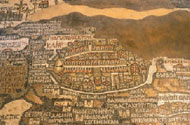- Best Deals
-
Locations
- Fleet
-
Services
Europcar in Jordan
About Jordan
Geography of Jordan
Jordan is situated geographically in Southwest Asia, south of Syria, west of Iraq Northwest of Saudi Arabia and east of and the West Bank in a region also known as the Middle or Near East. The territory of Jordan today covers about 91,880 square kilometers.
Jordan is landlocked except at its southern extremity where nearly twenty-six kilometers of shoreline along the Gulf of Aqaba provide access to the Red Sea. A great north-south geological rift, forming the depression of Lake Tiberias (Sea of Galilee), the Jordan Valley, and the Dead Sea, is the dominant topographical feature.
Amman
Amman, the capital of Jordan, is a fascinating city of contrasts; a unique blend of old and new, ideally situated on a hilly stretch between the desert and the fertile Jordan Valley. In the commercial heart of the city ultra-modern buildings, hotels, smart restaurants, art galleries and boutiques rub shoulders comfortably with traditional coffee shops and tiny artisanal workshops. Due to the city’s modern-day prosperity and temperate climate, almost half of Jordan’s population is concentrated in the Amman area.
The residential suburbs consist of mainly tree-lined streets and avenues flanked by elegant, almost uniformly white houses in accordance with municipal law which states that all buildings must be faced with local stone. The downtown area is much older and more traditional, with smaller businesses producing and selling everything from fabulous jewellery to everyday household items. The people of Amman are multi-cultural, multi-denominational, well-educated and extremely hospitable. They welcome visitors and take pride in showing them around this fascinating and vibrant city.
| Jerash This is one of the best preserved province cities of the Roman Empire. A close second to Petra on the list of favorite destinations in Jordan, the ancient city of Jerash boasts an unbroken chain of human occupation dating back more than 6,500 years. The city's golden age came under Roman rule and the site is now generally acknowledged to be one of the best-preserved Roman provincial towns in the world. Hidden for centuries in sand before being excavated and restored over the past 70 years, Jerash reveals a fine example of the grand, formal provincial Roman urbanism that is found throughout the Middle East. This comprises paved and colonnaded streets, soaring hilltop temples, handsome theatres, spacious public squares and plazas, baths, fountains and city walls pierced by towers and gates. Beneath its external Greco-Roman veneer, Jerash also preserves a subtle blend of east and west. Its architecture, religion and languages reflect a process by which two powerful cultures meshed and coexisted - The Greco-Roman world of the Mediterranean basin and the ancient traditions of the Arab Orient. |
 | Mount Nebo This site marks the mountain from which Moses was allowed to see the Holy land. From Mount Nebo’s windswept promontory, overlooking the Dead Sea, the Jordan River Valley, Jericho and the distant hills of Jerusalem, Moses viewed the Holy Land of Canaan that he would never enter. He died and was buried in Moab, "in the valley opposite Beth-Peor" (Deuteronomy 34:6). His tomb remains unknown. After consulting the Oracle, Jeremiah reportedly hid the Ark of the Covenant, the Tent and the Altar of Incense at Mount Nebo. Mount Nebo became a place of pilgrimage for early Christians from Jerusalem and a small church was built there in the 4th century to commemorate the end of Moses' life. Some of the stones from that church remain in their original place in the wall around the apse area. |
 | Petra Known as the rose-red city half as old as time, the ancient city of Petra is one of Jordan's national treasures and by far its best known tourist attraction. Located approximately three hours south of Amman, Petra is the legacy of the Nabataeans, an industrious Arab people who settled in southern Jordan more than 2,000 years ago. Admired then for its refined culture, massive architecture and ingenious complex of dams and water channels, Petra is now a UNESCO World Heritage Site that enchants visitors from all corners of the globe. Much of Petra's appeal comes from its spectacular setting deep inside a narrow desert gorge. The site is accessed by walking through a kilometer long chasm (or Siq), the walls of which soar 200m upwards. Petra's most famous monument, the Treasury, appears dramatically at the end of the Siq. Used in the final sequence of the film "Indiana Jones and the Last Crusade," the towering façade of the Treasury is only one of myriad archaeological wonders to be explored at Petra. Various walks and climbs reveal literally hundreds of buildings, tombs, baths, funerary halls, temples, arched gateways, colonnaded streets and haunting rock drawings. Also to be found there is a 3,000 seat open air theatre, a gigantic 1st century Monastery and a modern archeological museum, all of which can be explored at leisure. A modest shrine commemorating the death of Aaron, brother of Moses, was built in the 13th century by the Mamluk Sultan, high atop mount Aaron in the Sharah range. |
 | WadiRum This area is known as The Valley of the Moon, and was the setting for the film Lawrence of Arabia. The moonlike landscape of Wadi Rum is unique to the world. The desert of Rum is dotted with massive mountains, colored in shades of red, yellow, and orange. Their hues spill over to color the sand dunes around the desert and the horizon of its breathtaking panorama. This is a place where you can become one with nature, where visitors are humbled by the towering mountains and overwhelmed by the serenity and quiet ambiance of this magnificent place. The eco-system of Wadi Rum holds many rare and endemic plants, with spring revealing hundreds of species of wild flowers. About 120 bird species have been recorded in the area, including the Griffon Vulture, the Fan-Tailed Raven, Bonelli’s Eagle, and Hume’s Tawny Owl. Baseline surveys show the existence of the Grey Wolf, Blandford’s Fox, the Sand Cat, and the Ibex within the area. |
 | Madaba Known as the City of Mosaics, Madaba is perched on 4,000-year-old archaeological site. The city, best known for its spectacular Byzantine and Umayyad mosaics, is home to the famous 6th century mosaic map of Jerusalem and the Holy Land. With two million pieces of colored stone, the map depicts hills and valleys, villages and towns as far as the Nile Delta. Other mosaic masterpieces found in the Church of the Virgin and the Apostles and the Archaeological Museum, depict a rampant profusion of flowers and plants, birds and fish, animals and exotic beasts, as well as scenes from mythology and everyday pursuits of hunting, fishing and farming. Hundreds of other mosaics from the 5th through to the 7th centuries are scattered throughout Madaba's churches and homes. |
 | Hammamat Ma'in / Ma'in Hot Springs The City of Mosaics, perched on 4,000-year-old archaeological site. The first city to encounter is Madaba, the City of Mosaics." The city, best known for its spectacular Byzantine and Umayyad mosaics, is home to the famous 6th century mosaic map of Jerusalem and the Holy Land. With two million pieces of colored stone, the map depicts hills and valleys, villages and towns as far as the Nile Delta. Other mosaic masterpieces found in the Church of the Virgin and the Apostles and the Archaeological Museum, depict a rampant profusion of flowers and plants, birds and fish, animals and exotic beasts, as well as scenes from mythology and everyday pursuits of hunting, fishing and farming. Literally, hundreds of other mosaics from the 5th through the 7th centuries are scattered throughout Madaba's churches and homes. |
 | Bethany This is a unique site where 2000 years ago Jesus came to see John to be baptized by him. The site of John the Baptist's settlement at Bethany Beyond the Jordan, where Jesus was baptized, has long been known from the Bible (John 1:28 and 10:40) and from the Byzantine and medieval texts. The site has now been identified on the east bank of the Jordan River, in the Hashemite Kingdom of Jordan, and is being systematically surveyed, excavated, restored, and prepared to receive pilgrims and visitors. Bethany Beyond the Jordan is located half an hour by car from the Jordanian capital Amman. The Bethany area sites formed part of the early Christian pilgrimage route between Jerusalem, the Jordan River, and Mount Nebo. The area is also associated with the biblical account of how the Prophet Elijah (Mar Elias in Arabic) ascended to heaven in a whirlwind on a chariot of fire. |














